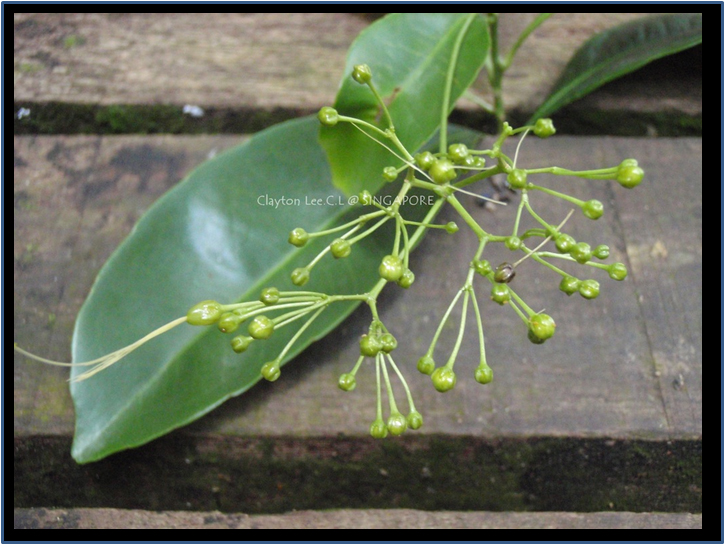Ixonanthes icosandra Jack, Mai. Misc. 2, 7, 53 (1822)
Species name meaning 'twenty male parts', referring to the number of stamens.Synonyms
Brewstera crenata MJ Roemer
Ixonanthes cuneata Miq.
Ixonanthes dodecandra Griff.
Ixonanthes icosandra var. cuneata Miq.
Ixonanthes icosandra var. obovata Ridl.
Ixonanthes lucida Blume
Ixonanthes obovata Hook.f.
Macharisia isosandra Planch.
Pierotia lucida Blume
Diagnostics
A small to medium-sized tree, up to 30 m tall and with bole up to 1.3 m in diameter, but often
much less; crown dense and conical, bark smooth or slightly fissured. Young inflorescence axes,
petioles etc. not glaucous. Lenticels inconspicuous. Petiole pulvinate. Leaf margin slightly
glandular-serrate. Peduncle slightly flattened and distally faintly grooved with four ridges;
primary branches sub-4-vvhorled around the usually developed terminal flower of the peduncle.
Disk entire. Stamens (15-)20. Ovules 2 per cell, usually only one fertile. Capsule ovoid-conical,
acute. Seeds with a suprahilar arillode, without a basal wing; arillode as long as the seed,
fleshy, cream-coloured.
Description
Trees or treelets up to 30 m tall and 1.3 m diameter. Bole straight, sometimes with short
stilt roots. Bark smooth or slightly shallowly fissured, red, fawn, brown, or grey, soft.
Innre bark red, purplish-red, reddish brown, or brown. Wood white, orange, yellow, brown,
cream brown, or brownish red, hard. Leaf scars +/- orbiculate to triangular.
Stipules up to 0.6 mm long. Leaves oblong to slightly obovate oblong, 6-19 by 3-6.5 cm,
pergamentaceous, base tapering, apex obtuse, often retuse, apiculate; petiole 2-3 mm, pulvinate.
Peduncle 6-14 cm; pedicels 3-15 mm; bracts up to 5 mm long. Flowers at anthesis 2-3 by 1-2 mm
diameter, whitish-yellow. Sepals elliptic, 1-1.5 by 0.8-1 mm, c. 0.3 mm thick at the base, margin +/- hyaline,
subcoriaceous in fruit. Filaments ultimately up to 15 mm long; anthers basi-droso-versatile.
Style up to 10 mm. Ovary top-shaped, +/- 5-angular, c. 0.5 by 0.7 mm. Capsule 15(-20) by 5-6
mm, green to dark brown. Seeds ellipsoid, 10 by 2 mm; arillode adaxillary, tripartite.
[from Flora Malesiana]
Ecology
The species in found in primary as well as secondary forests on slopes and ridges from sea-level
up to 900 m.
Uses
The bark is used for tanning purposes, usually only for toughening fishing nets, but sometimes
also for the production of leather. The timber is sometimes used in house building. Leaves and
roots are used in traditional medicine. The timber is considered of little value as it is not
durable and is liable to split.
Distribution
Thailand, Peninsular Malaysia, Sumatra.
Local names
Indonesia: pagar (general), kayu bulus (Bangka), kase beranak (Palembang).
Malaysia: pagar anak, mepagar, mertajong (Peninsular).
Sumatra: kayu leja-leja, kassi branah, kayu ratuh, pempaaga, kayu beluks.
Thailand: aa sai (Pattani).
